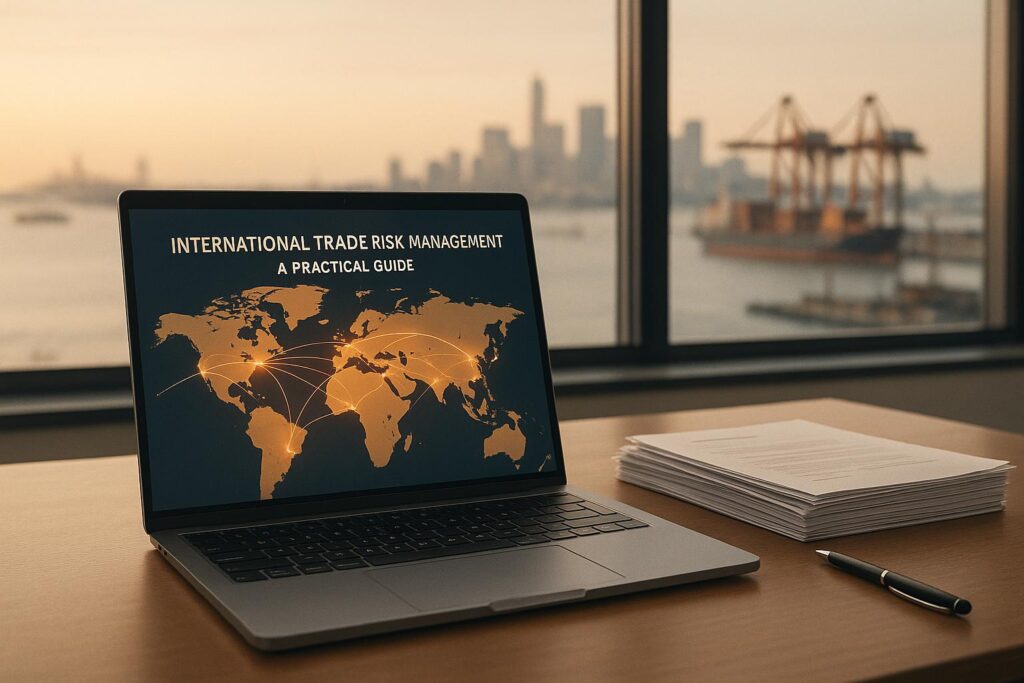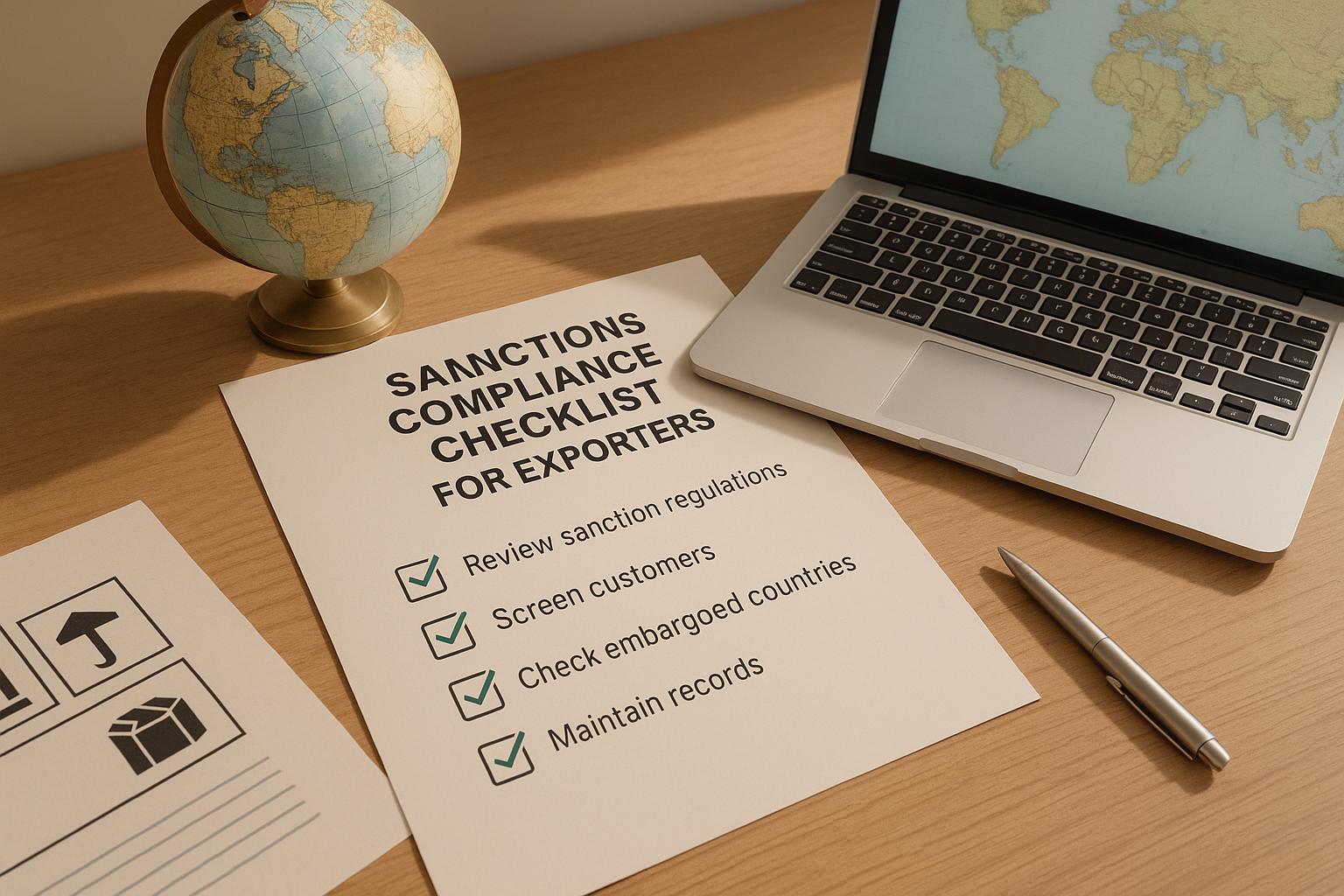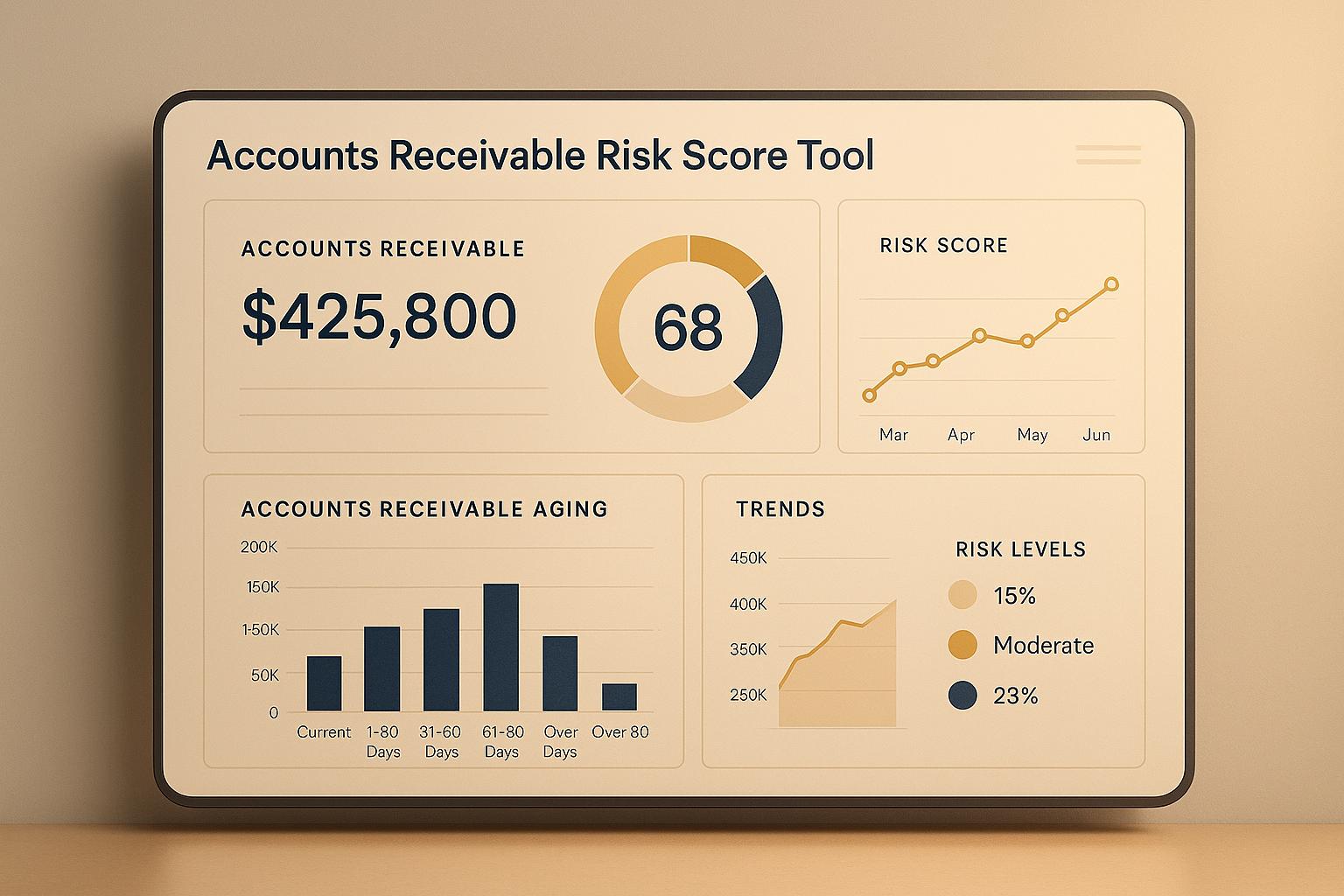Want to protect your business in global trade? Here’s how to manage risks effectively:
- Understand Common Risks:
- Currency Risk: Exchange rate fluctuations can impact costs and revenue.
- Political Risk: Instability or trade barriers can disrupt operations.
- Credit Risk: Non-payment or cash flow issues from customers.
- Supply Chain Risk: Delays or reliance on a single supplier.
- Legal/Regulatory Risk: Compliance and contract disputes.
- Key Risk Management Strategies:
- Early Detection: Spot risks in supply chains, credit, and markets to act fast.
- Financial Tools: Use trade credit insurance, letters of credit, and currency hedging.
- Diversify Supply Chains: Avoid over-reliance on single suppliers or regions.
- Country Research: Assess political and economic stability before entering markets.
- Protect Your Business:
- Secure trade credit insurance to cover up to 95% of invoice value.
- Build contingency plans with backup suppliers and alternative shipping routes.
- Use AI tools to monitor risks in real-time.
- Train Your Team: Equip staff with skills to identify risks, ensure compliance, and analyze markets.
Quick Tip: Start by assessing your current trade risks and implementing tools like credit insurance or supply chain diversification. These steps can save your business from financial losses and ensure smooth global operations.
Credit Insurance as a Risk Mitigation Tool for International Trade
Risk Assessment Methods
Navigating risks in international trade calls for a structured approach to spot and address potential threats before they disrupt your business. The following methods outline how to evaluate and mitigate risks effectively.
Buyer Credit Checks
Understanding your buyer’s financial health and reputation is crucial. Here’s what to focus on:
| Assessment Component | Key Information Sources | What to Evaluate |
|---|---|---|
| Financial Records | Credit Reports, Bank References | Payment History, Debt Ratios |
| Business History | Trade References, Industry Reports | Years in Operation, Market Position |
| Legal Standing | Public Records, Court Documents | Pending Litigation, Regulatory Compliance |
"Knowing your market, the type of buyer you are selling to, i.e., whether they are end-users, consumers or industrials, and getting to know all about your buyer and their culture." – Gabriel Ojeda, President of Fitz-Pak Corporation and EXIM Bank advisory board member
For businesses in developed markets, standardized credit reports often suffice. In contrast, emerging markets may require additional local research to fill in gaps.
Country Risk Research
Evaluating a country’s risk involves looking at a mix of economic and political factors that could influence trade. Credit ratings from agencies like Standard & Poor’s (S&P) and Moody’s are a good starting point. Markets rated BBB- or higher by S&P and Baa3 or higher by Moody’s are considered investment-grade.
Key Economic Indicators to Examine:
- GDP growth trends
- Currency stability
- Debt-to-GDP ratio
- Banking system health
Political Factors to Consider:
- Government stability
- Regulatory policies
- Openness to foreign investment
- Participation in trade agreements
For example, in January 2023, GreenTech Solutions utilized the U.S. Commercial Service‘s Initial Market Check service to evaluate Brazil. Their analysis flagged potential regulatory and currency risks. As a result, they secured political risk insurance and adopted currency hedging strategies. These proactive measures helped them achieve a 20% increase in sales during their first year in the market.
Supply Chain Analysis
A thorough supply chain risk assessment identifies weak points that could disrupt operations. Focus on these areas:
- Transportation Routes: Review shipping lanes, transit times, and alternative routes for critical shipments.
- Supplier Dependencies: Check for over-reliance on specific suppliers and assess their financial and operational stability.
- Regulatory Compliance: Ensure adherence to import/export laws and customs regulations in all jurisdictions involved.
Risk Protection Methods
Protecting your international trade operations is all about having the right strategies in place. Here’s how you can safeguard your business:
Financial Safety Tools
Financial tools are essential to reduce risks in trade transactions. For instance, trade credit insurance can cover up to 95% of your invoice value. Considering that about 40% of a company’s assets are often tied up in trade debts, this kind of protection is critical for maintaining stability.
| Protection Method | Primary Benefits | Cost Considerations |
|---|---|---|
| Trade Credit Insurance | Covers 85–95% of invoice value for non-payment | Costs less than 1% of insured sales volume |
| Documentary Collections | Controls the timing of goods release | Charges based on individual transactions |
| Letters of Credit | Offers bank-guaranteed payment | Incur per-transaction fees |
| Forward Contracts | Secures exchange rates | Premium depends on currency pair |
"Accounts receivable insurance has allowed us to take on customers and transactions we wouldn’t have felt comfortable taking on by ourselves… It has not only allowed my company to take on larger deals, but be more liberal in terms, and the result has gone straight to our bottom line." – Mike Libasci, President of International Fleet Sales
After securing your finances, turning your attention to supply chain resilience is the next step.
Supply Source Planning
Global uncertainties and the IMF’s projected 2.8% growth for 2025 highlight the importance of building a resilient supply chain.
Key Steps for a Stronger Supply Chain:
- Diversification Strategy
Avoid relying on a single supplier or region by creating regional supply hubs. Having backup suppliers in different areas can help protect against disruptions caused by localized issues. - Risk Monitoring System
Regularly evaluate supplier performance and market conditions. Keep an eye on metrics like delivery times, product quality, and financial health to spot risks early. - Contingency Planning
Develop alternative plans for sourcing critical materials. Build and maintain relationships with secondary suppliers to ensure you’re prepared for unexpected challenges.
"Like it or not, we are well into a transition – not just away from the economic interdependence and value chain integration, but potentially, a disorderly transition away from the principles, or rules-based economic order, that we have known for three generations." – Navin Girishankar, President at the Economic Security and Technology Department
Once your supply chain is fortified, structuring trade agreements effectively adds another layer of security.
Trade Agreement Structure
Well-organized trade agreements, particularly those based on Incoterms® 2020, can prevent confusion and clearly outline risk responsibilities.
Key Elements of Trade Agreements:
- Define precise delivery points and locations.
- Specify insurance coverage requirements.
- Clearly assign responsibility for handling charges.
For contracts using CIF or CIP terms, ensure that insurance coverage aligns with the agreed terms.
Additional Contract Essentials:
- Payment terms and conditions
- Quality control standards
- Dispute resolution procedures
- Force majeure clauses
It’s important to note that Incoterms® rules focus on dividing risks and costs during delivery, not on ownership transfer. For complete protection, address ownership changes separately in your sales contract. This ensures there are no gaps in your agreements.
sbb-itb-2d170b0
Trade Credit Insurance Guide
Insurance Basics
Trade credit insurance (TCI) is designed to protect businesses from commercial and political risks that can arise in international trade. This includes scenarios like bankruptcy, insolvency, war, or currency inconvertibility.
Core Policy Components:
| Coverage Type | Protection Level | Typical Premium Cost |
|---|---|---|
| Medium-term | 85% of contract value | Varies by risk profile |
| Single-buyer | Variable coverage | Risk-based pricing |
If a customer fails to pay within the agreed timeframe, the claims process begins. However, policyholders must provide proper documentation and proof of collection efforts before filing a claim.
Grasping these basics sets the stage for understanding the broader benefits of TCI.
Key Insurance Advantages
Trade credit insurance offers more than just risk protection – it can be a strategic tool for business growth. In 2019, the global TCI market was valued at $9.39 billion, with projections reaching $18.14 billion by 2027.
Strategic Benefits:
- Confidence in extending credit: Safely offer credit terms to new customers.
- Supports market expansion: Enter new markets with reduced financial risk.
- Improves borrowing capacity: Use protected receivables as collateral for financing.
- Access to credit insights: Gain valuable information about potential customers’ creditworthiness.
"Export risk management is not about eliminating risks… Instead, risk management is about taking steps to ensure that a company knows what and how much risk it faces and how much of that risk it is able to mitigate." – Allianz Trade
One real-world example highlights its value: A U.S.-based pharmaceutical company needed to distribute millions of infectious disease test kits internationally but faced concerns about non-payment. By securing trade credit insurance, the company mitigated payment risks, enabling them to distribute the kits efficiently and confidently.
Policy Customization Steps
Customizing a TCI policy ensures it aligns with your business’s unique risk profile and trade operations. Premium rates typically range from 0.05% to 0.6%, with 0.2% being a common average.
Key Customization Options:
- Coverage Structure: Decide between whole turnover coverage (protecting all eligible buyers) or selective coverage that focuses on specific high-risk customers.
- Risk Assessment: Evaluate factors like:
- Customer credit profiles
- Geographic risks
- Industry-specific vulnerabilities
- Historical payment behaviors
- Policy Features: Choose features that best match your needs. For example:
| Feature Type | Description | Best For |
|---|---|---|
| Top-up Coverage | Additional protection above limits | Large individual transactions |
| Collections Integration | Combines receivables management | Companies with limited resources |
| Flexible Credit Limits | Adjustable coverage for buyers | Growing businesses |
Policies generally cover less than 100% of losses, requiring businesses to share some of the risk through deductibles. To ensure you get the best fit for your trade patterns and risk tolerance, consider working with specialized insurance brokers who can guide you toward cost-effective solutions.
Risk Management Setup
Building on earlier strategies for assessing and mitigating risks, strengthening internal systems and providing staff training are key to bolstering global trade defenses.
Risk Tracking Systems
AI-powered tools offer real-time monitoring across global supply chains, keeping a close eye on suppliers, shipments, and potential risks as they arise.
Key System Features:
| Component | Function | Business Impact |
|---|---|---|
| AI Risk Alerts | 24/7 monitoring with instant notifications | Cuts response time by up to 5 days |
| Automated Scorecards | Predictive modeling for supplier assessment | Reduces screening time by 60% |
| API Integration | Real-time data synchronization | Updates data every 1–5 minutes |
| Mobile Access | On-the-go risk screening | Boosts team responsiveness |
A great example of this in action is Danone. By integrating 60% of its procurement categories into a unified risk management platform, the company achieved a 20% growth in business by creating more resilient supply chains.
While technology ensures constant vigilance, having a well-trained team is essential to interpret data and act effectively on the insights provided.
Staff Risk Training
Equip your team with the skills to quickly spot and address trade risks.
Core Training Areas:
1. Risk Identification
Teach employees to recognize early warning signs, such as supplier instability, quality issues, or potential disruptions.
2. Compliance Knowledge
Ensure staff understand trade compliance and export controls. For instance, the U.S. Customs and Border Protection‘s Office of Trade Relations offers targeted training events covering critical compliance topics.
3. Market Analysis Skills
Provide training in assessing international markets and e-commerce opportunities. The International Trade Administration offers detailed video resources on export strategies and global e-commerce operations.
Regular Policy Updates
To stay prepared, pair technology and training with routine policy updates. Regular reviews ensure your risk management strategies remain effective and up-to-date.
Suggested Update Schedule:
| Review Type | Frequency | Focus Areas |
|---|---|---|
| Routine Assessment | Monthly | Customer credit profiles, payment trends |
| Market Analysis | Quarterly | Industry trends, economic signals |
| Comprehensive Review | Annually | Policy terms, coverage adequacy |
"We’re able to quickly provide BITE to more teammates and affiliates given the cost model and self-service account management, allowing us to create a wider compliance and security blanket." – Drew Cano, Export Compliance Officer
For businesses to stay ahead, they must regularly evaluate their risk management processes. This includes updating assessments, monitoring supplier performance, and adjusting coverage levels to align with changing market conditions. Strong collaboration with supply chain partners ensures a more robust defense against potential disruptions.
Summary: Global Trade Protection
Building on the earlier discussion of risk assessments and protection strategies, let’s dive into a streamlined approach to safeguarding global trade. In 2020, 14.52% of world trade was secured by credit insurance, underscoring its increasing role in international commerce.
Key Elements of Risk Management
Here’s a breakdown of the essential components that support a strong global trade strategy:
| Component | Key Focus |
|---|---|
| Risk Assessment | Evaluating markets and buyers |
| Financial Protection | Ensuring trade credit coverage |
| Supply Chain Security | Implementing diversification strategies |
| Compliance Management | Providing training and staying updated |
These pillars are crucial for building a robust and adaptable trade framework. A well-structured plan not only minimizes vulnerabilities but also fosters confident market expansion. Alp Benadrete, Managing Partner at EDPA, shared his experience with Allianz Trade:
"The Allianz Trade team made us feel so comfortable about the situation and confident that it would get resolved. When you are facing an enormous financial loss, having someone knowledgeable, supportive, and responsive in your corner can make all the difference. We are very happy with the service we received."
The goal of risk management isn’t to eliminate risks entirely – it’s about effectively managing and mitigating exposure.
Tips for Maintaining Strong Protection
To stay ahead in a volatile global market, consider the following steps:
- Keep a close eye on economic trends.
- Leverage advanced risk assessment tools.
- Build relationships with trusted legal advisors.
- Secure trade credit insurance to prepare for economic uncertainties.
- Regularly review and update company policies.
FAQs
What are the best ways to manage currency risk in international trade?
Managing currency risk in international trade is crucial to shielding your business from potential financial hits caused by exchange rate shifts. Here are some key approaches to consider:
- Pay in U.S. dollars: When possible, structure agreements so payments are made in U.S. dollars. This eliminates the risk tied to fluctuating foreign currencies.
- Use currency hedging tools: Instruments like forward contracts or currency options can help you secure exchange rates in advance, reducing unpredictability.
- Leverage natural hedging: Match your revenues and expenses in the same foreign currency. This way, gains and losses from currency movements balance out.
By implementing these methods, you can better protect your business from the uncertainties of exchange rate volatility, making international trade a more stable endeavor.
What steps can businesses take to comply with international trade regulations and avoid legal issues?
To navigate international trade regulations and reduce legal risks, businesses need a well-thought-out strategy. It starts with staying up-to-date on the trade laws and regulations in every country where you operate. Double-check that all your paperwork – like invoices, contracts, and customs declarations – is accurate and securely stored.
Drafting clear and regulation-compliant contracts is another key step. Collaborating with reliable local agents or advisors who understand the nuances of the trade environment can also provide valuable guidance. Regular employee training on compliance requirements, along with internal audits or risk assessments, helps catch potential problems before they escalate. Building a company-wide commitment to compliance ensures everyone is aligned in following the rules and managing risks effectively.
How can companies diversify their supply chains to minimize risks from relying on single suppliers or regions?
To broaden your supply chain and avoid over-reliance on a single supplier or region, start by mapping out your current supplier network. Pinpoint any single-source suppliers or critical components that could disrupt your operations if issues arise.
Once you have a clear picture, evaluate your needs and determine the right mix of suppliers. Consider factors like how essential each item is and how demand might shift over time. You can find potential new suppliers through industry contacts, trade directories, or by sending out Requests for Quotes (RFQs).
When you’re ready, start shifting some of your orders to these new suppliers to create a more balanced and resilient network. Make it a habit to regularly track supplier performance to ensure they’re meeting your standards and to maintain adaptability. Remember, diversification isn’t a one-time task – it’s an ongoing strategy to protect your business from global trade disruptions.



